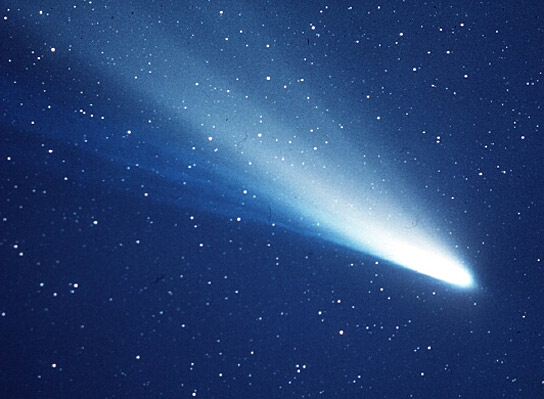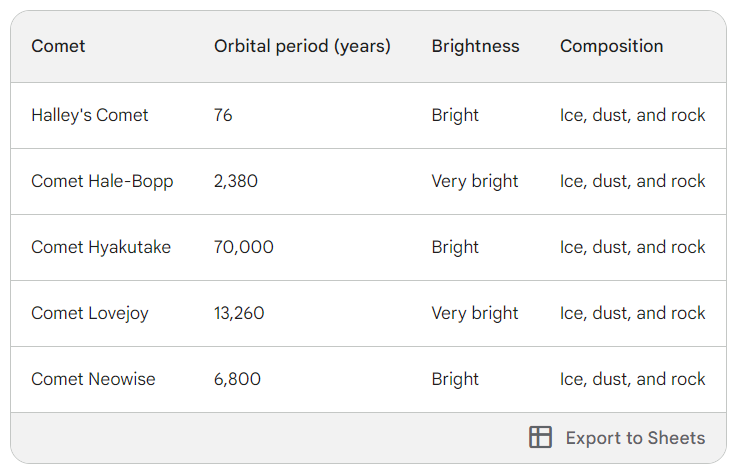Halley’s Comet is one of the most famous comets in the world. It is a periodic comet, meaning that it orbits the Sun on a regular basis. 1P/Halley is visible to the naked eye from Earth every 75-79 years.

When was Halley’s Comet first discovered?
Halley’s Comet was first discovered in 240 BC by Chinese astronomers. However, it was not until 1705 that English astronomer Edmond Halley predicted that the comet would return in 1758. Halley’s prediction was correct, and the comet was seen again in 1758. This was the first time that a comet had been predicted to return.
How often does 1P/Halley appear in the sky?
Halley’s Comet appears in the sky every 75-79 years. This is because it takes the comet about 76 years to orbit the Sun.
What is the composition of 1P/Halley?
Halley’s Comet is made up of ice, dust, and rock. The ice is made up of water, carbon dioxide, and other gases. The dust and rock are made up of silicates, metals, and other minerals.
How does Halley’s Comet get its tail?
As 1P/Halley approaches the Sun, the ice on its surface begins to melt. This releases gas and dust, which form a tail behind the comet. The tail of 1P/Halley can be millions of miles long.
Is Halley’s Comet dangerous?
Halley’s Comet is not dangerous. It is too far away from Earth to pose any threat.
What are some of the most famous sightings of Halley’s Comet?
1P/Halley has been seen by many people throughout history. Some of the most famous sightings include:
- 1066: 1P/Halley was seen by the Normans before they invaded England.
- 1453: 1P/Halley was seen by the Byzantines before Constantinople fell to the Ottoman Turks.
- 1682: 1P/Halley was seen by Edmond Halley.
- 1910: 1P/Halley was seen by millions of people around the world.
- 1986: 1P/Halley was seen by millions of people around the world. It was also the first comet to be visited by spacecraft.
What can we learn from Halley’s Comet?
Halley’s Comet can teach us a lot about the formation of the solar system and the evolution of comets. Comets are thought to be the leftovers from the formation of the solar system. They contain information about the conditions that existed early in the solar system’s history.
What is the difference between a comet and an asteroid?
Comets and asteroids are both small objects that orbit the Sun. However, there are some key differences between the two. Comets are made up of ice, dust, and rock. Asteroids are made up of rock and metal. Comets also have tails, which are made up of gas and dust. Asteroids do not have tails.
How long does Halley’s Comet stay in the sky?
Halley’s Comet stays in the sky for several months. The amount of time it spends in the sky depends on its orbit. In 1986, 1P/Halley was visible in the sky for about two months.
What is the best way to see Halley’s Comet?
The best way to see Halley’s Comet is to find a dark location away from city lights. You may also need to use a telescope or binoculars to see the comet in detail.
What are some of the myths and legends about 1P/Halley?
There are many myths and legends about Halley’s Comet. Some people believe that the comet is a bad omen and that it brings bad luck. Others believe that the comet is a sign of the apocalypse. However, there is no scientific evidence to support any of these claims.
How will Halley’s Comet change in the future?
1P/Halley will continue to orbit the Sun and appear in the sky every 75-79 years. However, the comet will gradually lose its ice and dust as it approaches the Sun. This means that the comet will become less and less visible over time.
1P/Halley: A Unique Comet in Our Solar System
1P/Halley is one of the most unique and well-studied comets in our solar system. It is a periodic comet, meaning that it orbits the Sun on a regular basis. Halley’s Comet has an orbital period of about 76 years, which is relatively short compared to other comets.
Another unique feature of 1P/Halley is its composition. It is made up of a mixture of ice, dust, and rock, which is typical of comets. However, 1P/Halley has a higher proportion of ice than many other comets. This is because 1P/Halley has a relatively short orbital period, which means that it spends less time in the inner solar system, where the Sun’s heat can melt the ice.
1P/Halley is also one of the brightest comets in the sky. This is because of its high ice content and its relatively short orbital period. 1P/Halley is often visible to the naked eye, even from urban areas.
Here is a comparison of Halley’s Comet with some other known comets:

As you can see, Halley’s Comet is relatively similar to other comets in terms of its composition and brightness. However, it is unique in its short orbital period. 1P/Halley is also one of the most well-studied comets, which has helped astronomers to learn more about these fascinating objects.
In addition to the above, here are some other unique features of 1P/Halley:
- It is the only known comet that is regularly visible to the naked eye from Earth.
- It is the first comet to have been photographed.
- It was the first comet to be visited by spacecraft.
1P/Halley is a truly unique and fascinating object. It is a reminder of the wonders of the universe and the importance of scientific exploration.
1P/Halley vs. the Green Comet: A Celestial Comparison
Halley’s Comet and the green comet are two of the most famous and anticipated comets in history. Halley’s Comet is a short-period comet that returns to Earth’s inner solar system every 76 years, while the green comet is a long-period comet that makes a close approach to Earth every 50,000 years.
Both comets are fascinating celestial objects, but there are some important differences between them. Here is a comparison of Halley’s Comet and the green comet in several key areas:
Orbital period: Halley’s Comet has an orbital period of 76 years, while the C 2022 E3 (ZTF) has an orbital period of 50,000 years. This means that Halley’s Comet is much more likely to be seen by humans during their lifetime than the green comet.
Visibility: Halley’s Comet is typically much brighter than the green comet, making it easier to see with the naked eye. The green comet is expected to be visible to the naked eye for a few weeks before and after it makes its closest approach to Earth on February 2, 2023, but it is not expected to be as bright as Halley’s Comet was during its last appearance in 1986.
Composition: Both comets are made up of ice, dust, and rock. However, the C 2022 E3 (ZTF) has a unique greenish hue due to the presence of diatomic carbon molecules in its coma. Diatomic carbon is excited by ultraviolet light from the sun, causing it to emit green light.
Origin: Halley’s Comet is thought to have originated in the Oort cloud, a spherical cloud of icy bodies that is located at the edge of the solar system. The green comet is also thought to have originated in the Oort cloud, or possibly in the Kuiper belt, a region of icy bodies that is located beyond Neptune.
Significance: Both Halley’s Comet and the green comet are important to scientists because they can provide insights into the formation and evolution of the solar system. Halley’s Comet has been studied by scientists for centuries, and it has helped us to learn a great deal about comets and their behavior. The C 2022 E3 (ZTF) is a new and exciting discovery, and scientists are eager to learn more about it.
Overall, Halley’s Comet and the C 2022 E3 (ZTF) are two very different comets. However, they are both fascinating objects that can offer us a glimpse into the wonders of the universe.
FAQs
Q: Is Halley’s Comet dangerous?
A: No, Halley’s Comet is not dangerous. It is too far away from Earth to pose any threat. 1P/Halley orbits the Sun at an average distance of about 28 AU (Astronomical Units). An AU is the distance between the Earth and the Sun, which is about 93 million miles. 1P/Halley can come as close as 0.59 AU to Earth, but this is still a very safe distance.
Even if 1P/Halley were to collide with Earth, it would not cause a catastrophic event. 1P/Halley is relatively small, with a nucleus that is only about 9 miles in diameter. The impact of Halley’s Comet with Earth would be similar to the impact of a large asteroid, which could cause regional damage but would not be a global threat.
In addition, 1P/Halley is made up of ice, dust, and rock. This means that it would not be as destructive as a comet that was made up of solid rock. The ice and dust in Halley’s Comet would vaporize upon impact, which would help to reduce the damage caused by the impact.
Overall, there is no reason to be afraid of 1P/Halley. It is a beautiful and fascinating object that is safe to observe and enjoy.
Q: What is the best way to see Halley’s Comet?
A: The best way to see Halley’s Comet is to find a dark location away from city lights. You may also need to use a telescope or binoculars to see the comet in detail.
Here are some additional tips for seeing 1P/Halley:
- Check the weather forecast before you go. Halley’s Comet is best seen on clear nights.
- Arrive at your viewing location early. The comet is often brightest in the early morning hours, before sunrise.
- Dress warmly. It can get cold at night, especially if you are viewing the comet from a dark location.
- Be patient. It may take some time for your eyes to adjust to the darkness and for you to see the comet.
Once you have found a good viewing location, simply look up at the sky and scan for a bright object with a tail. Halley’s Comet is typically visible to the naked eye, but a telescope or binoculars will give you a better view.
Q: How long will Halley’s Comet be visible in the sky?
Halley’s Comet will be visible in the sky for several months. The amount of time it spends in the sky depends on its orbit. In 1986, 1P/Halley was visible in the sky for about two months.
Q: What will Halley’s Comet look like?
Halley’s Comet will appear as a bright object with a tail. The tail of the comet can be millions of miles long. The comet may also appear to have a greenish hue.
Is there anything else I can do to prepare for viewing Halley’s Comet?
There are a few other things you can do to prepare for viewing 1P/Halley:
- Learn about the comet’s orbit. This will help you to know when and where to look for it in the sky.
- Read up on the history of Halley’s Comet. This will help you to appreciate the significance of this event.
- Share your excitement with others. Tell your friends and family about Halley’s Comet and invite them to join you in viewing it.
Halley’s Comet is a truly unique and amazing sight. By following these tips, you can make the most of this once-in-a-lifetime experience.
